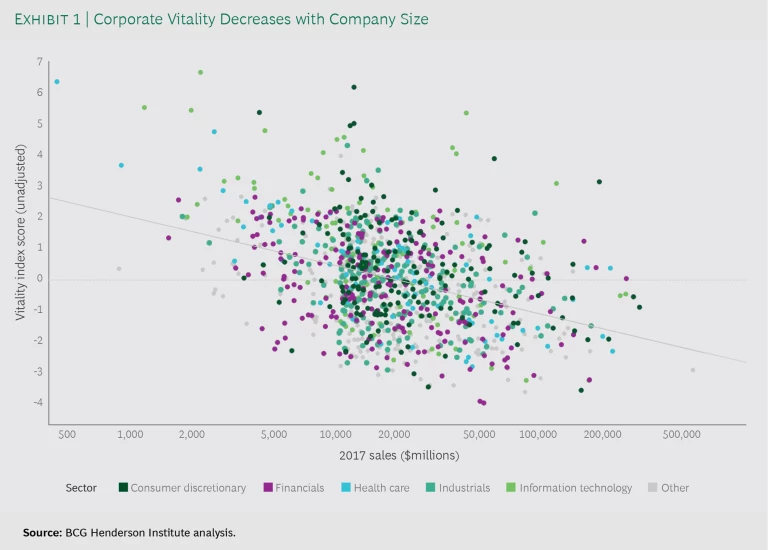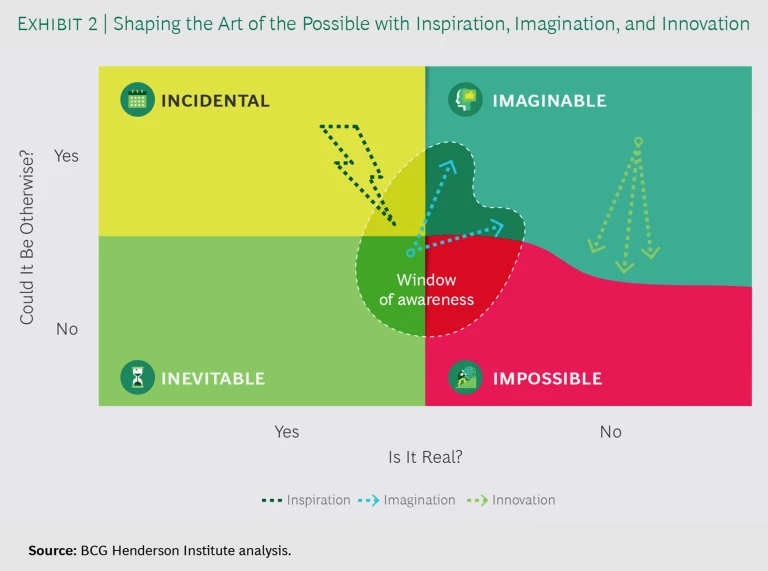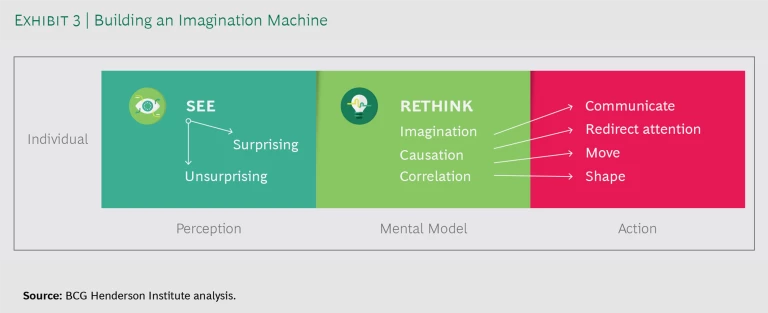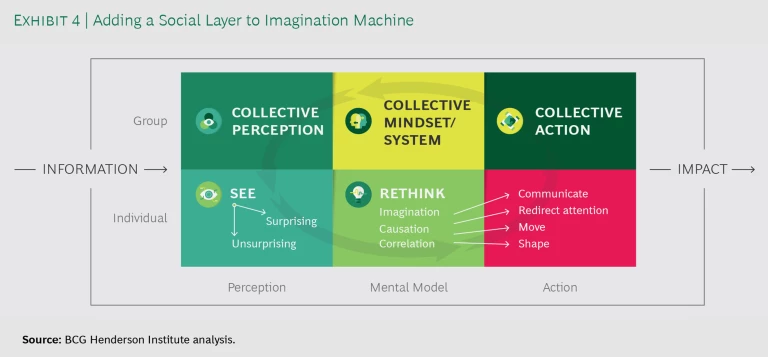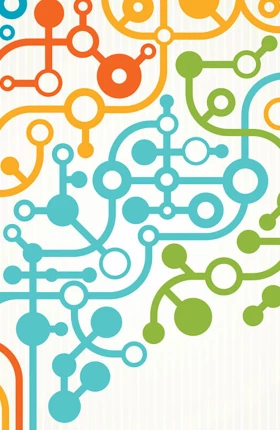As business environments become more changeable and long-term growth rates decline, companies increasingly need to innovate—across their operations, offerings, and business models. We know the powerful effects of innovation, but what is upstream of innovation? How can we understand and shape the murky mental territory that leads to good ideas: the realm of imagination?
Big businesses often struggle to make use of imagination. They may try to make it a predictable process, and they end up with routinization and incrementalism. Or they may treat it like a magical power, celebrated in tales of great innovators, in the hope that good ideas will appear as needed. As companies grow, it becomes harder to be imaginative. Larger companies tend to focus on exploiting what they know and what originally gave them scale. Corporate vitality—the potential for future growth and reinvention—decreases with size.
Companies must increasingly compete on imagination, but we don’t have a clear idea of how imagination works or how to systematically improve it. How can we cultivate imaginative capacity, rather than leaving it to chance, intuition, or mechanistic processes?
What Imagination Is
We can see what imagination is by comparing humans with other animals. An animal like a fish lives in the realm of “what is.” A goldfish works with just what is in front of it; it has no standpoint from which to reflect on its situation.
Imagination is the ability to think counterfactually. Rather than living in the realm of what is, imagination gives us the ability to explore the realm of what is not but could be, enabling us to conceive and create new things and to shape what is. (See Exhibit 2.)
The two boxes on the left side of Exhibit 2 cover the realm of “what is the case,” divided into what is inevitable and what is incidental. The two boxes on the right cover “what is not,” divided into things that are currently impossible—teleportation, a mind-reading machine, pet dinosaurs—and plausible possibilities. In the center is the “window of awareness” we each have into these areas.
Reading across the boxes, we can see the possibility of a process of inspiration leading to imagination and then to innovation. We get inspired observing anomalies, analogies, and accidents (the lightning bolt). Inspiration feeds our imagination, which pushes us to mentally sketch new possibilities (the arrows expanding the window of awareness). This leads to innovation, which moves things from imaginable to real, often expanding the boundaries of what is possible (the arrows expanding the space of imaginable possibilities).
Amazon, for example, began with Jeff Bezos reflecting on an anomaly: “The wake-up call was finding this startling statistic that web usage in the spring of 1994 was growing at 2,300 percent a year. You know, things just don’t grow that fast. It’s highly unusual, and that started me thinking, ‘What kind of business plan might make sense in the context of that growth?’”
How Imagination Works
Let’s look at how imagination works, starting at the level of an individual. Individual imagination is part of a process involving perception, thinking, and taking action. (See Exhibit 3.)
See
Our brains are constantly using sensory input, plus memories and concepts, to create a mental model, like a controlled hallucination of reality.
A surprise is anything that brings new information to the model, causing us to overturn some assumptions or adjust the implicit probability we assigned to them. Three types of surprise inspire imagination: anomalies (aspects in our information flow that are out of the ordinary); analogies (similarities we notice between concepts or experiences, which lead us to imagine new possibilities); and accidents (unexpected actions and consequences that draw our attention to something interesting).
Rethink
Let’s suppose you receive a surprising piece of information: you reach for your wallet but it is not in your pocket. Your brain will hypothesize about what happened. At the most basic level of thought, it can look at historical data and find patterns. This is how AI currently works. In such a situation, an AI algorithm would effectively ask “What other things have tended to be true, when it is true that my wallet is not in my pocket?” If it had a large enough data set, say a thousand occasions, it might be able to say “There is a 4% probability it has been stolen, a 63% probability you have left it in a taxi,” and so on. You could then act on these newly calculated probabilities.
However, human brains can work at a higher level than just correlating facts. Even if it has never happened before, you can ask “What if my wallet was stolen?” And you can paint a mental picture of what things would be like if that were the case, sketch another scenario of losing it, and compare the two. Your ability to create this counterfactual sketch is your imaginative capacity.
Once the ability to elaborate mentally is unleashed, it can take you much further than just imagining what happened to your wallet: You can imagine ways to help you keep track of your wallet in the future, or even dream up new services, like a “find my iPhone” tool but for everything in your life. Or you can picture new opportunities for businesses in a cashless and cardless world.
Act
Imagination, the process of elaborating counterfactuals, isn’t just an isolated mental activity. Our thinking leads to action, and what we learn from acting can further feed our imagination. The action might involve communicating our ideas, redirecting attention to new objects or signals, moving in the world to change our perspective, or shaping some aspect of the world by doing an experiment or creating a prototype.
For example, early last century, Charles Merrill revolutionized banking.
Imaginative elaboration leads to action and is then further provoked by action. In the early days of Amazon, Bezos sent an email to 1,000 customers asking what they would buy online if they could. The lists came back very long and random, covering everything from windshield wipers to groceries. And this prompted Bezos to continue to imagine: “A light kind of went on in my head. You know people—they will want to use this newfangled e-commerce way of shopping for everything.”
The Social Dimension
Imaginative achievements, however, are not produced by just one person. One’s own imagination works in conjunction with the perceptions, imaginations, and actions of others to create the possibility of collective innovation. To the diagram in Exhibit 3 we can therefore add a social layer. The individual act of imagining is part of a cycle that can span an entire organization or business ecosystem. (See Exhibit 4.)
When individuals communicate (the bottom-right box), this enables amplification and collective action. Over time, collective action shapes a set of habits, roles, and expectations, the collective mindset, which can become a self-sustaining system (top-center box). These habits and expectations shape the ideas that are shared and promoted in the group: collective perception. We experience this as knowing what to avoid and what will go down well in certain meetings, for example, and as group pressure to adopt shared ideas—which can be either productive or unproductive depending on how well attuned the organization is to the environment. To close the loop, this group influence partly shapes how individuals see the world: what they notice and find surprising and inspiring—the triggers for individual imagination.
Returning to our earlier example, Charles Merrill’s imaginative ideas were developed in communication with others, particularly researcher Ted Braun, and led to collective actions: research, and efforts to engage and change the ideas of an often recalcitrant company.
What Stops Big Companies from Being Imaginative
Turning a company or business ecosystem into an imagination machine requires a focus not only on imaginative individuals but also on the entire collective imagination cycle in which individuals are embedded. Looking at the steps in Exhibit 4, we can identify the points at which collective imagination can fail in big companies.
- Size leads to less outside exposure. Imagination is triggered by surprising information—new patterns of data, a question from a different perspective, interesting encounters that don’t fit within one’s current model of the world. We can think of companies as spheres: the greater the radius, the lower the ratio of surface area to volume. Larger companies become miniature societies in themselves, with proportionally more people tethered within the society and fewer connecting with the outside world. When there is less exposure to what is surprising and unpredictable, there is less to feed the imagination.
- The main focus is on averages rather than exceptions (accidents, anomalies, and new analogies). Another bottleneck in perception is the tendency to overlook outliers. This is partly due to reporting: we report in averages—period average sales figures and performance reviews for example—so that people higher up can get an overall picture. This may be an efficient approximation, but it means that anomalies, which may be change signals or sources of inspiration, aren’t often given attention. Leaders might have something to learn from an incidental failed or successful sale, which could prompt their imagination. In terms of personnel, it is often safer to keep someone around who is predictably “pretty good,” rather than people with more erratic profiles who may help prompt the imagination. Organizations tend to reward the predictably average.
- Mental models become stuck. The mental models of a successful organization tend to become uniform (a downside of overemphasizing alignment) and entrenched. For example, an officer in the British army before the Second World War, J.F.C. Fuller, tried to introduce the concept of tank warfare, but because everyone was used to fighting on horseback, the idea was dropped.
12 12 See “Why big companies squander good ideas,” Financial Times, September 6, 2018. He insightfully imagined what warfare would look like with tanks, but his vision couldn’t be taken up because it didn’t fit with the prevailing way of seeing things. This problem is compounded by a lack of cognitive diversity and a lack of self-awareness of mental models. The inherited mental model is often implicit and treated as common sense or mistaken for objective reality. - The tyranny of metrics takes over. Companies often focus on executing one business model, and its associated targets and metrics become the main ways of judging success. But the dominance of such metrics can come at the expense of seeing possibilities and dabbling with new models. When there is a standard, clear way to measure and reward success, efforts in any other direction can look like failures or a waste of time. We account for the things that are easily accounted for, at the expense of important things that are not, like imagination.
- Roles become highly specified. In large companies it can make little sense to act outside what you are expected to accomplish. But imagination often works by following up on serendipitous moments, which can lead you far from what you expected you would be doing. The refrigerator, for example, was invented in 1854 by James Harrison, an Australian working as a self-employed printer. He noticed that when he used ether to clean the movable type of the printing press, the metal felt curiously cold afterwards. He realized that the evaporating vapor removed heat from the object, and he set about experimenting (in a cave outside of town, because the experiments were explosive), eventually patenting a “refrigerating machine.”
13 13 Harrison’s birthday, April 17, is celebrated as International Refrigeration Day. See “James Harrison, Australia, and the World's First Patented Refrigerator.” It’s a challenge for large companies to give employees this kind of autonomy to explore. - Social transmission is lacking. Even if individuals are imaginative, there might be problems with the transmission of ideas across a group. One can imagine a company full of people with rich mental models and strong abilities to elaborate imaginatively, but where people don’t work together or collectively consider new questions and ideas. It’s harder to diffuse ideas and have shared conversations across a larger organization. Communication can be impeded by a high bar for proposing new ideas, a fear of failure, a lack of incentives to share, and restrictive reporting and communication protocols. Thus, the company does not make the best use of individual imaginations.
- Imagination is seen as being only mental. Roy Rosin, formerly vice president of innovation at Intuit, noted to the authors that “the best ideas are the ones that have had the most chance to evolve.” A key part of the imaginative process is action taken beyond mere communication: doing research, testing out early-stage efforts, scaling an imaginative idea. Without these efforts to shape or prod the world, there is no feedback and no surprising data to trigger further elaboration. Self-restriction often follows success: Walmart developed its big box retailer model, and then focused on refining it; PayPal went through multiple major pivots but is now exploiting its current, successful model; Twitter (then called Odeo) once gave its employees two weeks to come up with imaginative ideas to transform and save the company but has now settled into its micro-blogging platform.
14 14 See “14 Famous Business Pivots,” Forbes, October 8, 2013. Imagination ends up being treated as only a mental act, or a periodic cultural intervention, not a driver of research, speculative experiments, prototyping, or continuous transformation. The less effort we put into acting on imaginative suggestions, the less imagination we stimulate, and the more likely it is we will miss opportunities for innovation and growth
Building an Imagination Machine
How can we build an imagination machine—that is, a business where the imaginations of individuals working together are fully supported by design? We are only just beginning to understand how companies can compete on imagination, but here are some starting points.
Contact with the Unknown
An imaginative company would ensure that its members are regularly exposed to the unfamiliar and unknown, and trained to treasure it. This could involve sending staff on short secondments to very different work environments; the executive team spending time in places where their product is unsuccessful or unknown; and tailoring daily information flows to ensure that people are not simply reading business news or their habitual websites but encountering a variety of imagination-triggering inputs. Such a firm would take the task of delivering personalized, enriching, surprising information to its employees as seriously as it takes any other aspect of the business, because it would know that this feeds the imaginative capacity of the company.
Do you take deliberate steps to expose yourself and your employees to the unfamiliar, to create inspiration and enrich their mental models?
A Focus on Anomalies
The imagination machine would ensure that interesting anomalies are reported alongside averages and expected results. Each executive would perhaps be required to present at least one intriguing, thought-provoking, or befuddling thing they encountered in their domain once a week—whether the outlier is a particular person, an unexpected outcome of an experiment, something a group did on its own initiative, or an unusual observation. This practice would ensure that surprising information is shared rather than pushed aside, with the idea that some of these anomalies would provoke people’s imaginations.
Does your company focus on anomalies or averages?
Explicit Mental Models
A company that takes imagination seriously would be conscious of how mental models are choices rather than inevitabilities. The company would teach employees that the brain’s beliefs about reality are merely shifting probabilities, knowing that the collective capacity to entertain alternative views is aided by this awareness. The company would also articulate and share the core elements of the collective mental model on which the current business model rests. For example, a company might say “our business is based on the belief that people will need physical office supplies (we are 95% confident this will remain true for ten years) and that these will be distributed from factories (we’ve downgraded our confidence about this to 75% over the past few years).” Such self-awareness of assumptions and mental models facilitates the navigation and choice of alternative ones.
How explicit are the shared assumptions that constitute the collective mental model of your business? Are alternative framings of issues, challenges, and facts often discussed and entertained?
Counterfactual as well as Factual Skills
The imaginative company would focus on cultivating the mental skills underpinning imaginative thinking. This would not mean simply hiring people who present themselves as creative or who have experie
nce in creative industries. Rather, it would be about testing for the skills supporting imagination—skills that might show up in unexpected people. Candidates could be tested on contingent thinking (What are five “what if” questions you would ask in this business situation?); on their analogical ability (What analogies would be appropriate in this case? What is this an example of?); on their ability to expand a vague starting point into an interesting proposal; and on the Renaissance-person criterion of the depth and breadth of their worldview—the richness of the mental models they would bring to bear.
Do “what if” questions routinely get shot down with a “that’s not the case” type of response? Does your company assess, hire for, and cultivate counterfactual thinking? How often do you try to think of and learn from analogies?
Playfulness
An imagination machine would also understand and cultivate playfulness: improvised, imaginative exploration. Play involves testing out things that one can easily do but might not have thought to try yet, without much premeditation. Play can be mental (throwing around ideas) and physical (trying things out). Returning to J.F.C. Fuller and the British army, the military might have said “sure, let’s try training with some tanks.” This could be the precursor to a more serious experiment, but nonetheless a useful first step in trying out an idea. A company fostering playfulness would appreciate randomness and messiness as much as order, allowing people to tinker and customize, suggest idiosyncratic ideas in meetings, try out modifications to processes, and be forgiven for trying new things without permission. Allowing low-cost action and feedback is key to supporting the cycle of imagination.
Would you describe your company as playful? What would be different if it was? Is there a balance of messiness and order in your company?
Open Competition of Ideas
An imaginative company would also foster the expression and competition of ideas. This could be done in informal ways, with the CEO regularly soliciting ideas from her team, or more formally in firm-wide competitions. Employees could be asked provoking questions, and prizes could be offered for the most stimulating responses. The strategy team could also share stories and historical examples reminding people just how weird some things (fridges, staplers, printed books, gunpowder, cars) felt when they were completely new but how unexceptional they seem now. Recognizing how odd new things once seemed can help encourage consideration of interesting but unusual and untested ideas.
Are your employees encouraged to generate and propose imaginative ideas? What challenges or opportunities in your company or in the world could be the basis for a competition of ideas from across the firm?
Cognitive Diversity
Whether imagination works well is tied to how uniform and rigid our collective worldview is. One reason Polaroid was unable to take advantage of digital cameras is that the company was dominated by chemists. Some employees could imagine the future of digital cameras, but they failed to persuade the leadership.
Does your executive team comprise individuals who think in different ways and are encouraged to do so? Do discussions typically navigate contradictory viewpoints? Do you measure and cultivate cognitive diversity?
Evolving Routines and Models
Over time, the patterns of collective action in a company shape the dominant set of mental habits, roles, and expectations, which can become a self-sustaining system. The imagination machine is able to avoid such entrenchment by allowing routines and models to continuously evolve. Rather than being self-protecting, it becomes a self-tuning company, evolving and refining practices based on data and imagination. This may involve giving up on the vision that processes can or should be completely optimized for efficiency or perfect uniformity. Sometimes it is more important to preempt change, to allow something to change for the sake of freeing up room for subsequent innovations. Even if a routine is good in itself, there is an opportunity cost in allowing paths to become trenches and imagination to become sidelined.
How often have the processes you are part of been reimagined? Is your company set up to evolve its ways of working? How hard is it to change entrenched ways of doing things?
The idea that entrepreneurs imagine new businesses and big companies focus only on managing established ones at scale is falling apart. All companies, large ones included, face increasingly unpredictable environments and the prospect of stagnation or disruption if they do not continuously innovate. Fortunately, business environments are increasingly malleable, offering many new opportunities to create and capture value, if we can first imagine them. As well as competing on efficiency, we must increasingly compete on imagination. We need to get serious about understanding this capacity, how it works individually and collectively, and how to deploy it reliably and powerfully, especially in large businesses that have been successful through one way of doing and seeing things.

